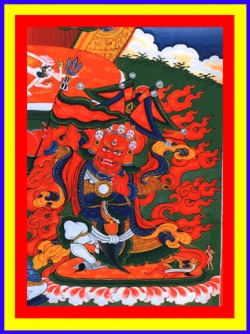Difference between revisions of "Wrathful deities"
(Created page with " In Buddhism, wrathful deities are enlightened beings who take on wrathful forms in order to lead sentient beings to enlightenment. They are a notable feature of the iconograp...") |
|||
| Line 1: | Line 1: | ||
| − | + | [[File:Begtse-g.JPG|thumb|250px|]] | |
In Buddhism, wrathful deities are enlightened beings who take on wrathful forms in order to lead sentient beings to enlightenment. They are a notable feature of the iconography of Mahayana Buddhism and of Tibetan Buddhism, and other Vajrayana traditions in particular. A wrathful deity is often an alternative manifestation of a bodhisattva or other normally peaceful figure, making the representations of all human vices and atrocities. True to their name, in Tibetan art, wrathful deities are presented as fearsome, demonic beings adorned with human skulls. | In Buddhism, wrathful deities are enlightened beings who take on wrathful forms in order to lead sentient beings to enlightenment. They are a notable feature of the iconography of Mahayana Buddhism and of Tibetan Buddhism, and other Vajrayana traditions in particular. A wrathful deity is often an alternative manifestation of a bodhisattva or other normally peaceful figure, making the representations of all human vices and atrocities. True to their name, in Tibetan art, wrathful deities are presented as fearsome, demonic beings adorned with human skulls. | ||
==Categories== | ==Categories== | ||
Wrathful deities can be divided into several categories: | Wrathful deities can be divided into several categories: | ||
| − | + | *The Herukas (Tb. khrag 'thung, lit. "blood drinker"), which are enlightened beings who adopt fierce forms to express their detachment from the world of ignorance. | |
| − | + | *The Wisdom Kings (Sanskrit vidyarāja), known particularly as the protectors of the Five Dhyani Buddhas; more a feature of Japanese than Tibetan Buddhism | |
| − | + | *The Protectors (Sanskrit pāla), usually subdivided into three categories: Lokapālas or "Protectors of the World" are guardians of the four cardinal directions | |
| − | + | **[[Four Heavenly Kings|Lokapālas]] or "Protectors of the World" are guardians of the four cardinal directions | |
| − | + | **Kṣetrapālas or "Protectors of the Region" | |
| + | **[[Dharmapala|Dharmapālas]] or "Protectors of the Law" which vary in the level of realization attributed to them. This can be anything from fully enlightened to an oath-bound worldly spirit. Most of the major Dharmapalas are said to be enlightened. | ||
==Eight Dharmapalas== | ==Eight Dharmapalas== | ||
The Eight Dharmapalas (Sanskrit: Dharma, 'religion'; Pala, 'protector'), known in Tibetan as Drag-gShed (Standard Tibetan: དྲག་གཤེད). The Dharmapalas, or defenders of Buddhism, are supernatural beings with the rank of Bodhisattva, who "are supposed to wage war without any mercy against the demons and enemies of Buddhism". The Eight Dharmapala are: | The Eight Dharmapalas (Sanskrit: Dharma, 'religion'; Pala, 'protector'), known in Tibetan as Drag-gShed (Standard Tibetan: དྲག་གཤེད). The Dharmapalas, or defenders of Buddhism, are supernatural beings with the rank of Bodhisattva, who "are supposed to wage war without any mercy against the demons and enemies of Buddhism". The Eight Dharmapala are: | ||
| − | + | *[[Yama]], the God of Death; | |
| − | + | *[[Mahakala]], the Great Black One; | |
| − | + | *[[Yamantaka]], the Conqueror of Death; | |
| − | + | *[[Kubera]] or [[Vaisravana]], the God of Wealth; | |
| − | + | *[[Hayagriva]], the Horse-necked one; | |
| − | + | *[[Palden Lhamo]], The Goddess; | |
| − | + | *[[Tshangs Pa]] or ‘White Brahma’; | |
| − | + | *[[Begtse]], the God of War. | |
| + | |||
{{W}} | {{W}} | ||
| − | [[Category: | + | [[Category:Wrathful deities]] |
Revision as of 05:32, 19 June 2013
In Buddhism, wrathful deities are enlightened beings who take on wrathful forms in order to lead sentient beings to enlightenment. They are a notable feature of the iconography of Mahayana Buddhism and of Tibetan Buddhism, and other Vajrayana traditions in particular. A wrathful deity is often an alternative manifestation of a bodhisattva or other normally peaceful figure, making the representations of all human vices and atrocities. True to their name, in Tibetan art, wrathful deities are presented as fearsome, demonic beings adorned with human skulls.
Categories
Wrathful deities can be divided into several categories:
- The Herukas (Tb. khrag 'thung, lit. "blood drinker"), which are enlightened beings who adopt fierce forms to express their detachment from the world of ignorance.
- The Wisdom Kings (Sanskrit vidyarāja), known particularly as the protectors of the Five Dhyani Buddhas; more a feature of Japanese than Tibetan Buddhism
- The Protectors (Sanskrit pāla), usually subdivided into three categories: Lokapālas or "Protectors of the World" are guardians of the four cardinal directions
- Lokapālas or "Protectors of the World" are guardians of the four cardinal directions
- Kṣetrapālas or "Protectors of the Region"
- Dharmapālas or "Protectors of the Law" which vary in the level of realization attributed to them. This can be anything from fully enlightened to an oath-bound worldly spirit. Most of the major Dharmapalas are said to be enlightened.
Eight Dharmapalas
The Eight Dharmapalas (Sanskrit: Dharma, 'religion'; Pala, 'protector'), known in Tibetan as Drag-gShed (Standard Tibetan: དྲག་གཤེད). The Dharmapalas, or defenders of Buddhism, are supernatural beings with the rank of Bodhisattva, who "are supposed to wage war without any mercy against the demons and enemies of Buddhism". The Eight Dharmapala are:
- Yama, the God of Death;
- Mahakala, the Great Black One;
- Yamantaka, the Conqueror of Death;
- Kubera or Vaisravana, the God of Wealth;
- Hayagriva, the Horse-necked one;
- Palden Lhamo, The Goddess;
- Tshangs Pa or ‘White Brahma’;
- Begtse, the God of War.
